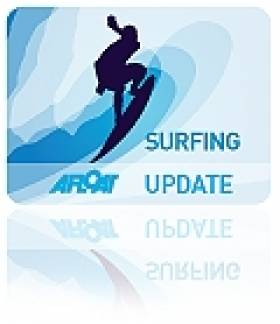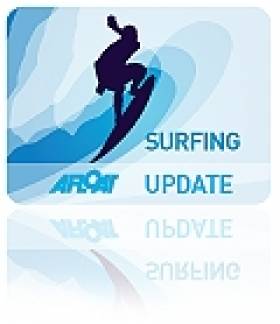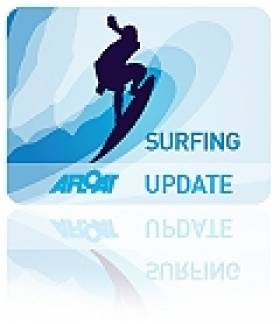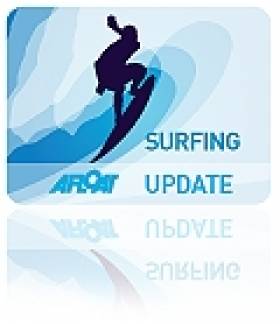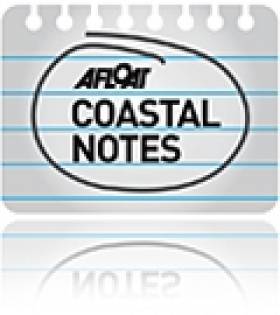Displaying items by tag: Surfing
Surfing is Ireland's 'Best Kept Secret' No More
#SURFING - Ireland can no longer claim to be the surfing world's best kept secret, as the Irish Examiner reports, as thousands of waveriders of all skill levels now flock annually to the west and northwest coasts to sample the swell.
Indeed, Ireland is arguably the hottest place to be for surfing right now, and RTÉ Travel rounds up the best spots to hit the water around the coast - including some that might surprise you.
Bundoran is this country's surfing mecca, and for good reason. Recently making National Geographic's list of the world's top 20 surfing towns, the Co Donegal surf capital has spots for everyone from experts to beginners, and boasts a choice of 10 surf schools affiliated with the Irish Surfing Association.
Further down the coast is Sligo, renowned among the surfing elite for the giant rollers off Mullaghmore Head but also a great place for learners, especially at Strandhill and Enniscrone - although "big waves, clean waters and great surfing" are to be found anywhere along the coastline.
Mayo continues the trend, with Bertra in Clew Bay and Keel Strand in Achill standing out, while Clare is home to the famed waves at Lahinch - home turf for big wave surfer Ollie O'Flaherty.
Further along, Kerry and West Cork can boast of a number of top-class surfing destinations, including some stretches just perfect for absolute beginners.
But it doesn't end there, as even the southeast and east coasts can hold their own - as Tramore in Co Waterford and Brittas Bay in Co Wicklow can attest.
Irish Surf Champions To Be Decided in Bundoran This Weekend
#SURFING - Surfers all over Ireland have been urged to come and try to take bragging rights away from North West at the Bundoran Board Riders Irish Championships Tour event this weekend 29-30 September at Tullan Strand or the Peak, depending on surfing conditions.
The event is the last scheduled on the 2012 Irish Championships Tour and eight Irish champions will be crowned, including Open Surf, Women's Surf, Open Bodyboard, Women's Bodyboard, Longboard, Master, Senior and Stand-Up Paddle (SUP).
The weekend will also include a Women's Longboard event, and the Junior Interclub Championships that were postponed earlier this year.
Other awards include the Shield, which will go to the highest scoring surf club (based on five individual placings from each club), as well as competition in the U18 Boys and U18 Girls divisions.
Surfers who want to compete can pre-register by posting cheque or postal order to the treasurer of Bundoran Board Riders, Dr Philip Murphy, Tullan Strand Road, Bundoran, Co. Donegal to arrive by Thursday 27 September, or register on the day at 8.30am sharp. No late entries accepted!
The entry fee is €10 for the first event and €5 for additional events. All entrants must present a 2012 Irish Surfing Association (ISA) membership card at registration. Tour categories are open to Irish citizens or British citizens born in Northern Ireland (proof of citizenship may be requested).
Keep updated on the Facebook event page HERE.
Singing the Praises of Cold Water Surfing in Ireland
#SURFING - Surfer and photographer Rob Gilley talks up the "cooler horizons" of surfing in Ireland for Surfer Magazine.
Responding to another surfer's arrogance in wondering why anyone would want to travel to surf in cold water when there are so many warmer spots in the world, Gilley goes on to outline his own preference for more frigid climes.
"On those particular trips I had discovered a longer lasting, deeper satisfaction," he writes. "A more profound stoke."
The theory behind his reasoning? "It's harder to feel euphoric when you're sweaty."
If that doesn't convince you, he posits the scenario of a "perfect, draining" afternoon's surfing in Ireland, then getting into a warm car and stopping at a pub "by a roaring fire" with a creamy Guinness into an empty stomach. "Case dismissed."
Surfer Magazine has more on the story, including Gilley's photos, HERE.
Irish Surfers Finish Sixth at Eurojuniors
#SURFING - The Irish Junior Surf Team finished sixth overall at the 2012 European Junior Surfing Championship in France at the weekend.
Among the 19-strong team competing in the week-long contest at Lacanau-Océan was Meadb McCloskey, who scored Ireland's highest individual ranking - placing fifth in the U18 Girls Bodyboard.
France came tops in a strong field to claim overall first place at Sunday's grand final, followed by Spain and Portugal.
As Surfer Today reports, 'Les Bleus' dominated across the divisions, taking every title except the U18 Boys and U18 Girls Bodyboard, won by Spain and Germany respectively.
Laois Surfers Hit the West Coast for Winter Surfing Season
#SURFING - Landlocked Laois may not be the known for its surfing prowess, but the Midlands county's waveriders have a busy winter season ahead of them, as the Leinster Express reports.
Laois Surf Club members regularly frequent the popular surfing spots of Ireland's west coast, and this autumn and winter is no exception.
First up was last weekend's Lahinch Longboard Contest organised by the West Coast Surf Club, to be followed by the annual inter-counties competition in Rossnowlagh, Co Donegal on 13-14 October.
“Being landlocked in Laois is a disadvantage but not a deterrent for those of us who enjoy and love surfing, it’s such good fun, healthy and you always feel great after a two-hour stint in the water,” said club chairman Steve Kidd.
The Leinster Express has more on the story HERE.
Clare Does the Double at Surf Lifesaving Nationals
#SURFING - The Irish Independent reports that the cream of Ireland's lifeguards comepeted at the National Surf Lifesaving Championships at Rossnowlagh, Co Donegal at the weekend.
Some 140 top lifesavers took part in events featuring a combination of surfing, surf-skiing and beach sprinting on the sun-and-surf-splashed strand - part of the preparations for November's World Lifesaving Championships in Australia.
Teams from Co Clare took the men's and over-30s titles - following the county's success at the European Lifesaving Championships in Sweden last month - while the women's top spot went to locals Donegal.
"Surf lifeguards have vital skills and every part of their training was on display," event organiser Seamus O'Neill of Irish Water Safety told the Independent.
Irish Team in France for Junior Surf Euros
#SURFING - The Irish Junior Surf Team departed yesterday for southwestern France to compete at the 2012 European Junior Surfing Championship at Lacanau-Océan which kicks off tomorrow.
The 19-strong team includes flagbearer Iarom Madden Traver and Cian Cagney in the U18 Boys division, Aaron O'Hare and Gearoid Mc Daid in the U16 Boys and Garbhan Mc Closkey and Dylan Noonan in the U14s Boys.
Ireland will be represented in the U18 Girls by Ayesha Garvey and Rachel Moore, while Eoin O'Malley Daly will compete in the Longboard event.
Meanwhile, Odhran McGovern and Kevin McGowan will challenge for the U18 Bodyboard, Cian McGovern and Oisin Cogan are in the U16 Bodyboards, and Meadb McCloskey is in the field for the U18 Girls Bodyboard.
Among the coaching staff joining the group are Irish Surf Team coach Pascal Devine and top female surf coach Shauna Ward, along with world-class bodyboarder Shane Meehan and U18 reserve Donough Cronin, who will both act as judges.
Heats will commence on Sunday 9 September running throughout the week, with the grand finals to take place the following Sunday 16 September.
The Irish Surfing Assocation has more HERE.
Meanwhile, Ireland's Glenn Hall as knocked out in the round of 16 at the ASP 6-Star San Miguel Pro Zarautz last week.
The Irish surf pro has established some impressive totals throughout the competition in Spain's Basque Country, but even his 13.40 in the fifth round wasn't enough to hold off the challenge of Ramzi Boukhiam, with the Moroccan pipping him by just 0.13 points.
Top Surfer Attends Special Beach Screening
#SURFING - Top Irish surfer Richie Fitzgerald was on hand for a special open-air screening of the award-winning surfing documentary Waveriders on Inchydoney beach in West Cork, as the Irish Examiner reports.
Fitzgerald, who stars in the 2009 film, attended the Movies on the Beach event on Saturday evening to help boost fundraising efforts for the Clonakilty Flood Relief Fund.
The former champion surfer has been witness to some of the most spectular waves off the Irish coast, including the biggest rollers in years recorded off Mullaghmore Head this past March.
Bundoran Makes List of World's Top 20 Surfing Towns
#SURFING - Bundoran in Co Donegal has been named one of the best surfing towns in the world by National Geographic.
Recommended for "the salty surf traveller who doesn't mind surfing in cold water or rain", the north-west surf hotspot is praised for the warmth of its locals as much as the quality of its waves.
Surfers are recommended to visit between September and November, when the Atlantic is in full churn - and most of the tourists have gone home!
Bundoran - which hosted last year's European Surfing Championships - is one of only three European beaches to make the list, along with Biarritz in France and San Sebastian in Spain.
Meanwhile, Australians are up in arms after the Gold Coast was snubbed by the National Geopgraphic list.
"As a surfer, I've been everywhere and this is paradise," local surf personality John Nielsen told GoldCoast.com.au. "In terms of waves, we've probably got the most selection of waves year-round that I've ever seen."
Byron Bay in New South Wales, described as the "spiritual and historical home of surfing", was the only Australian town to make the cut
The full National Geographic list of the world's best surf towns can be found HERE.
Swimming Ban at Clare Beaches Over E-coli Fears
#COASTAL NOTES - Surfers in Co Clare have been dealt a blow as the The Irish Times reports on a swimming ban at Lahinch and two other beaches over concerns of a potential outbreak of E-coli.
The beaches at Lahinch, Kilkee and Spanish Point ae covered by the ban, which was made by Clare County Council in consultation with the Health Service Executive after traces of E-coli were found in routine quality tests of the water.
Water runoff as a result of the recent heavy rainfall over the last few weeks has been blamed for the rise in bacteria levels, which has also seen Lahinch and Kilkee have their Blue Flag status suspended until they can meet the required quality standards.
The Irish Times has more on the story HERE.





























